Tourism: Difference between revisions
Undid revision 271971002 by 99.239.67.116 (talk) |
No edit summary |
||
| Line 1: | Line 1: | ||
{{Redirect|Tourist}} |
{{Redirect|Tourist}} |
||
[[ |
[[Image:Paris 06 Eiffelturm 4828.jpg|right|thumb|[[France]] has remained the most visited country in recent years.<ref>{{Cite web|year = 2007 | url=http://unwto.org/facts/eng/pdf/barometer/unwto_barom07_2_en.pdf|title = World Tourism Barometer (p.8)|format= PDF|publisher = World Tourism Organization|accessdate=2008-03-29}}</ref><ref>{{Cite web | year = 2007| title= Key facts on tourism 2007 Edition | url= http://www.tourisme.gouv.fr/fr/z2/stat/chiffres/att00009212/ccles_gb.pdf |format= PDF |author= Tourism Directorate (France)|accessadte=2008-03-29}}</ref>]] |
||
[[Image:Alhambra.png|thumb|180px|[[Alhambra]] in [[Granada]], [[Spain]]]] |
[[Image:Alhambra.png|thumb|180px|[[Alhambra]] in [[Granada]], [[Spain]]]] |
||
[[Image:Parthenon.JPG|thumb|180px|[[Parthenon]] in [[Athens]], [[Greece]]]] |
[[Image:Parthenon.JPG|thumb|180px|[[Parthenon]] in [[Athens]], [[Greece]]]] |
||
Revision as of 10:34, 20 February 2009

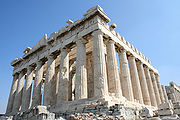

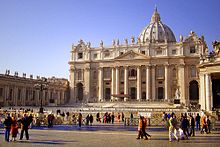



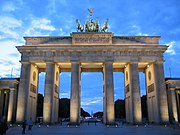
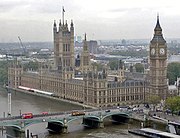

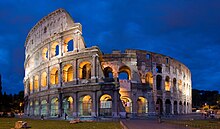

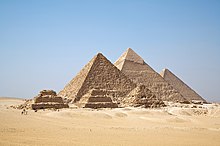



Tourism is travel for recreational or leisure purposes. The World Tourism Organization defines tourists as people who "travel to and stay in places outside their usual environment for not more than one consecutive year for leisure, business and other purposes not related to the exercise of an activity remunerated from within the place visited".[citation needed] Tourism has become a popular global leisure activity. In 2007, there were over 903 million international tourist arrivals, with a growth of 6.6% as compared to 2006. International tourist receipts were USD 856 billion in 2007.[4]
Despite the uncertainties in the global economy, international tourist arrivals during the first four months of 2008 followed a similar growth trend than the same period in 2007.[4] However, as a result of the economic crisis of 2008, international travel demand suffered a strong slowdown beginning in June 2008, with growth in international tourism arrivals worldwide falling to 2% during the boreal summer months, while growth from January to April 2008 had reached an average 5.7% compared to its 2007 level. Growth from 2006 to 2007 was only 3.7%, as total international tourism arrivals from January to August were 641 million tourists, up from 618 million in the same period in 2007.[5]
Tourism is vital for many countries such as U.A.E, Egypt, Greece, Thailand and many island nations such as The Bahamas, Fiji, Maldives, Seychelles due to the large intake of money for businesses with their goods and services and the opportunity for employment in the service industries associated with tourism. These service industries include transportation services such as cruise ships and taxis, accommodation such as hotels and entertainment venues, and other hospitality industry services such as resorts.
Definition
Hunziker and Krapf, in 1941, defined tourism as "the sum of the phenomena and relationships arising from the travel and stay of non-residents, insofar as they do not lead to permanent residence and are not connected with any earning activity."[6] In 1976, the Tourism Society of England defined it as "Tourism is the temporary, short-term movement of people to destination outside the places where they normally live and work and their activities during the stay at each destination. It includes movements for all purposes." [citation needed] In 1981, International Association of Scientific Experts in Tourism[7] defined Tourism in terms of particular activities selected by choice and undertaken outside the home environment.
The United Nations classified three forms of tourism in 1994 in its Recommendations on Tourism Statistics: Domestic tourism, which involves residents of the given country traveling only within this country; Inbound tourism, involving non-residents traveling in the given country; and Outbound tourism, involving residents traveling in another country.[citation needed]
The UN also derived different categories of tourism by combining the 3 basic forms of tourism: Internal tourism, which comprises domestic tourism and inbound tourism; National tourism, which comprises domestic tourism and outbound tourism; and International tourism, which consists of inbound tourism and outbound tourism. Intrabound tourism is a term coined by the Korea Tourism Organization and widely accepted in Korea. [citation needed] Intrabound tourism differs from domestic tourism in that the former encompasses policymaking and implementation of national tourism policies.[citation needed]
Recently, the tourism industry has shifted from the promotion of inbound tourism to the promotion of intrabound tourism because many countries are experiencing tough competition for inbound tourists.[citation needed] Some national policymakers have shifted their priority to the promotion of intrabound tourism to contribute to the local economy. Examples of such campaigns include "See America" in the United States, "Truly Asia" in Malaysia, "Get Going Canada" in Canada, "Wow Philippines" in the Philippines, "Uniquely Singapore" in Singapore, "100% Pure New Zealand" in New Zealand, "Amazing Thailand" in Thailand, "The Hidden Charm" in Vietnam and "Incredible India" in India.[citation needed]
World tourism statistics and rankings
Most visited countries
The World Tourism Organization reports the following ten countries as the most visited in 2007 by number of international travelers. When compared to 2006, Ukraine entered the top ten list, surpassing Russia, Austria and Mexico. Most of the top visited countries continue to be on the European continent.
| Rank | Country | UNWTO Regional Market |
International tourist arrivals (2007)[4] |
International tourist arrivals (2006)[8] |
|---|---|---|---|---|
| 1 | Europe | 81.9 million | 79.1 million | |
| 2 | Europe | 59.2 million | 58.5 million | |
| 3 | North America | 56.0 million | 51.1 million | |
| 4 | Asia | 54.7 million | 49.6 million | |
| 5 | Europe | 43.7 million | 41.1 million | |
| 6 | Europe | 30.7 million | 30.7 million | |
| 7 | Europe | 24.4 million | 23.6 million | |
| 8 | Europe | 23.1 million | 18.9 million | |
| 9 | Europe | 22.2 million | 18.9 million | |
| 10 | North America | 21.4 million | 21.4 million |
International tourism receipts
International tourist receipts were USD 96.7 billion in 2007, up from USD 85.7 billion in 2006. When the export value of international passenger travel receipts is accounted for, total receipts in 2007 reached a record of USD 1.02 trillion or 3 billion a day.[4] The World Tourism Organization reports the following 10 countries as the top ten tourism earners for the year 2007. It is noticeable that most of them are on the European continent, but the United States continues to be the top earner.
| Rank | Country | UNWTO Regional Market |
International Tourism Receipts (2007)[4] |
International Tourism Receipts (2006)[8] |
|---|---|---|---|---|
| 1 | North America | $96.7 billion | $85.7 billion | |
| 2 | Europe | $57.8 billion | $51.1 billion | |
| 3 | Europe | $54.2 billion | $46.3 billion | |
| 4 | Europe | $42.7 billion | $38.1 billion | |
| 5 | Asia | $41.9 billion | $33,9 billion | |
| 6 | Europe | $37.6 billion | $33.7 billion | |
| 7 | Europe | $36.0 billion | $32.8 billion | |
| 8 | Oceania | $22.2 billion | $17.8 billion | |
| 9 | Europe | $18.9 billion | $16.6 billion | |
| 10 | Europe | $18.5 billion | $16.9 billion |
International tourism top spenders
The World Tourism Organization reports the following 10 countries as the top ten biggest spenders on international tourism for the year 2007. For the fifth year in a row, German tourists continue as the top spenders.[4] A study by Dresdner Bank study[9] forecasts that for 2008 Germans and Europeans in general will continue to be the top spenders because of the strength of the Euro against the United States dollar, with strong demand for the US in favor of other destinations.[10]
| Rank | Country | UNWTO Regional Market |
International Tourism Expenditures (2007)[4] |
International Tourism Expenditures (2006)[8] |
|---|---|---|---|---|
| 1 | Europe | $82.9 billion | $73.9 billion | |
| 2 | North America | $76.2 billion | $72.1 billion | |
| 3 | Europe | $72.3 billion | $63.1 billion | |
| 4 | Europe | $36.7 billion | $31.2 billion | |
| 5 | Asia | $29.8 billion | $24.3 billion | |
| 6 | Europe | $27.3 billion | $23.1 billion | |
| 7 | Asia | $26.5 billion | $26.9 billion | |
| 8 | North America | $24.8 billion | $20.5 billion | |
| 9 | Europa | $22.3 billion | $18.2 billion | |
| 10 | Asia | $20.9 billion | $18.9 billion |
Most visited attractions
Forbes Traveller released a ranking of the world's 50 most visited tourist attractions in 2007, including both international and domestic tourists.[11] The following are the Top 10 attractions, followed by some other famous sites included within the list of the 50 most visited:[12] It is noticeable that 4 out of the top 5 are in the North America continent.
Most visited cities
Euromonitor released a ranking of the world's 150 most visited cities by international tourists in 2007.[3] The following are the leading 15 cities according to Euromonitor's ranking:
| Most visited cities by international tourists in 2007[3] Top 15 ranking cities | |||||||||||
| Ranking | City | Country | Number of intl. visitors (millions) |
Ranking | City | Country | Number of intl. visitors (millions) |
Ranking | City | Country | Number of intl. visitors (millions) |
|---|---|---|---|---|---|---|---|---|---|---|---|
| 1 | London | 15.34 | 6 | New York City | 7.65 | 11 | Barcelona | 5.04 | |||
| 2 | Hong Kong | 12.05 | 7 | Toronto | 6.63 | 12 | Seoul | 4.99 | |||
| 3 | Bangkok | 10.84 | 8 | Dubai | 6.54 | 13 | Shanghai | 4.80 | |||
| 4 | Singapore | 10.28 | 9 | Istanbul | 6.45 | 14 | Dublin | 4.63 | |||
| 5 | Paris | 8.76 | 10 | Rome | 6.12 | 15 | Kuala Lumpur | 4.40 | |||
However, other sources report Paris as the most visited city in the world with 30 million visitors.[13][14][15][16]
Also, Antalya municipality reported to have over 5.5 million international visitors in 2007 [1].
History


Wealthy people have always traveled to distant parts of the world to see great buildings and works of art, to learn new languages, to experience new cultures, and to taste different cuisines. As long ago as the time of the Roman Republic, places such as Baiae were popular coastal resorts for the rich. The word tourism was used by 1811 and tourist by 1840.[17] In 1936 the League of Nations defined foreign tourist as someone travelling abroad for at least twenty-four hours. Its successor, the United Nations amended this definition in 1945 by including a maximum stay of six months.[18]
Leisure travel
Leisure travel was associated with the industrialisation of United Kingdom – the first European country to promote leisure time to the increasing industrial population. [citation needed] Initially, this applied to the owners of the machinery of production, the economic oligarchy, the factory owners, and the traders. These comprised the new middle class. Cox & Kings were the first official travel company to be formed in 1758. [citation needed]
The British origin of this new industry is reflected in many place names. At Nice, France, one of the first and best-established holiday resorts on the French Riviera, the long esplanade along the seafront is known to this day as the Promenade des Anglais; in many other historic resorts in continental Europe, old well-established palace hotels have names like the Hotel Bristol, the Hotel Carlton or the Hotel Majestic - reflecting the dominance of English customers.
Many tourists do leisure tourism in the tropics both in the summer and winter. It is often done in places such as Cuba, Dominican Republic, Thailand, North Queensland in Australia and Florida in the United States.
Winter tourism
Major ski resorts are located in various mainland European countries, Canada, the United States, Australia, New Zealand, Japan, Korea, Chile and Argentina.
Mass tourism
Mass travel could only develop with improvements in technology allowed the transport of large numbers of people in a short space of time to places of leisure interest, and greater numbers of people began to enjoy the benefits of leisure time.
In the United States, the first great seaside resort, in the European style, was Atlantic City, New Jersey, and Long Island.
In Continental Europe, early resorts included Ostend (for the people of Brussels), and Boulogne-sur-Mer (Pas-de-Calais) and Deauville (Calvados) (for Parisians), and Heiligendamm (founded 1797 as the first seaside resort at the Baltic Sea).
Adjectival tourisms
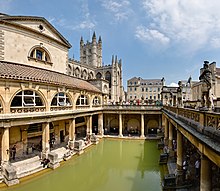
Adjectival tourism refers to the numerous niche or specialty travel forms of tourism that have emerged over the years, each with its own adjective. Many of these have come into common use by the tourism industry and academics. [citation needed] Others are emerging concepts that may or may gain popular usage. Examples of the more common niche tourism markets include:
- Culinary tourism
- Disaster tourism
- Dark tourism
- Ecotourism
- Heritage tourism
- LGBT tourism
- Medical tourism
- Nautical tourism
- Sex tourism
- Space tourism
- War tourism
Recent developments

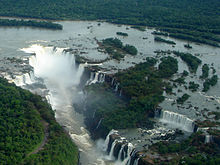


There has been an upmarket trend in the tourism over the last few decades, especially in Europe where international travel for short breaks is common. [citation needed] Tourists have higher levels of disposable income and greater leisure time and they are also better-educated and have more sophisticated tastes. [citation needed] There is now a demand for a better quality products, which has resulted in a fragmenting of the mass market for beach vacations; people want more specialised versions, such as Club 18-30, quieter resorts, family-oriented holidays, or niche market-targeted destination hotels.
The developments in technology and transport infrastructure, such as jumbo jets and low-cost airlines, and more accessible airports have made many types of tourism more affordable. There have also been changes in lifestyle, such as retiree-age people who sustain year round tourism. This is facilitated by internet sales of tourism products. Some sites have now started to offer dynamic packaging, in which an inclusive price is quoted for a tailor-made package requested by the customer upon impulse.
There have been a few setbacks in tourism, such as the September 11 attacks and terrorist threats to tourist destinations such as Bali and European cities. On December 26, 2004 a tsunami, caused by the 2004 Indian Ocean earthquake hit Asian countries bordering the Indian Ocean, and also the Maldives. Thousands of lives were lost, and many tourists died. This, together with the vast clean-up operation in place, has stopped or severely hampered tourism to the area.
The terms tourism and travel are sometimes used interchangeably. In this context travel has a similar definition to tourism, but implies a more purposeful journey. The terms tourism and tourist are sometimes used pejoratively, to imply a shallow interest in the cultures or locations visited by tourists.
Sustainable tourism
"Sustainable tourism is envisaged as leading to management of all resources in such a way that economic, social and aesthetic needs can be fulfilled while maintaining cultural integrity, essential ecological processes, biological diversity and life support systems." (World Tourism Organization)
Sustainable development implies "meeting the needs of the present without compromising the ability of future generations to meet their own needs" (World Commission on Environment and Development, 1987)[19]
Eco-tourism
Medical tourism
When there is a significant price difference between countries for a given medical procedure particularly in Southeast Asia, India and Eastern Europe or where there are different regulatory regimes between countries in relation to particular medical procedures (eg dentistry) travelling to take advantage of the price or regulatory differences is often referred to as "medical tourism".
Educational tourism
Educational tourism developed because of the growing popularity [citation needed] of teaching and learning of knowledge, and enhancing technical competency outside the classroom environment. In the educational tourism, the main focus of the tour or leisure activity includes visitation of another country to learn about the culture of the visited country (Student Exchange Program and Study Tour) or to work and apply their learning inside the classroom in different environment (International Practicum Training Program).
Other developments
Creative tourism Creative tourism has existed as a form of cultural tourism since the early beginnings of tourism itself. Its European roots date back to the time of the Grand Tour, which saw the sons of aristocratic families traveling for the purpose of (mostly interactive) educational experiences. More recently, creative tourism has been given its own name by Crispin Raymond and Greg Richards [citation needed], who as a member of the Association for Tourism and Leisure Education (ATLAS) has directed a number of projects for the European Commission, including cultural tourism, crafts tourism or sustainable tourism. They have defined "creative tourism" as tourism related to the active participation of travelers in the culture of the host community, through interactive workshops and informal learning experiences. [citation needed]
Meanwhile, the concept of creative tourism has been picked up by high-profile organizations such as UNESCO, who through the Creative Cities Network have endorsed creative tourism as an engaged, authentic experience that promotes an active understanding of the specific cultural features of a place. [citation needed]
More recently, creative tourism has gained popularity as a form of cultural tourism, drawing on active participation by travelers in the culture of the host communities they visit. Several countries offer examples of this type of tourism development, including the United Kingdom, Spain, Italy and New Zealand.
Dark tourism One emerging area of special interest tourism has been identified by Lennon and Foley (2000)[citation needed] as "dark" tourism. This type of tourism involves visits to "dark" sites such as battlegrounds, scenes of horrific crimes or acts of genocide, for example concentration camps. Dark tourism poses severe ethical and moral dilemmas: should these sites be available for visitation and, if so, what should the nature of the publicity involved be. Dark tourism remains a small niche market driven by varied motivations, such as mourning, remembrance, macabre curiosity or even entertainment. Its early origins are rooted in fairgrounds and medieval fairs.[20]
Growth
The World Tourism Organization (UNWTO) forecasts that international tourism will continue growing at the average annual rate of 4 %.[21] By 2020 Europe will remain the most popular destination, but its share will drop from 60% in 1995 to 46%. Long-haul will grow slightly faster than intraregional travel and by 2020 its share will increase from 18% in 1995 to 24%. [citation needed]
With the advent of e-commerce, tourism products have become one of the most traded items on the internet. [citation needed] Tourism products and services have been made available through intermediaries, although tourism providers (hotels, airlines, etc.) can sell their services directly. This has put pressure on intermediaries from both on-line and traditional shops.
It has been suggested there is a strong correlation between Tourism expenditure per capita and the degree to which countries play in the global context.[22] Not only as a result of the important economic contribution of the tourism industry, but also as an indicator of the degree of confidence with which global citizens leverage the resources of the globe for the benefit of their local economies. This is why any projections of growth in tourism may serve as an indication of the relative influence that each country will exercise in the future.
Space tourism is expected to "take off" in the first quarter of the 21st century, although compared with traditional destinations the number of tourists in orbit will remain low until technologies such as a space elevator make space travel cheap.[citation needed]
Technological improvement is likely to make possible air-ship hotels, based either on solar-powered airplanes or large dirigibles.[citation needed] Underwater hotels, such as Hydropolis, expected to open in Dubai in 2009, will be built. On the ocean, tourists will be welcomed by ever larger cruise ships and perhaps floating cities.[citation needed]
Latest trends
As a result of the economic crisis of 2008, international arrivals suffered a strong slowdown beginning in June 2008. Growth from 2007 to 2008 was only 3.7% during the first eight months of 2008. The Asian and Pacific markets were affected and Europe stagnated during the boreal summer months, while the Americas performed better, reducing their expansion rate but keeping a 6% growth from January to August 2008. Only the Middle East continued its rapid growth during the same period, reaching a 17% growth as compared to the same period in 2007.[5] This slowdown on international tourism demand was also reflected in the air transport industry, with a negative growth in September 2008 and a 3.3% growth in passenger traffic through September. The hotel industry also reports a slowdown, as room occupancy continues to decline.[5] As the global economic situation deteriorated dramatically during September and October as a result of the global financial crisis, growth of international tourism is expected to slow even further for the remaining of 2008, and this slowdown in demand growth is forecasted to continue into 2009 as recession has already hit most of the top spender countries, with long-haul travel expected to be the most affected by the economic crisis.[5]
Negative impacts
This section needs expansion. You can help by adding to it. (June 2008) |
Attracting a high volume of tourists can have negative impacts, such as the impact of 33 million tourists a year on the city of New York,[23] or the potential to impact fragile environments negatively,[24] or the impact of the December 26, 2004 tsunami on the tourists themselves.[25] The environment can be affected negatively by cruise ship pollution in many ways, including ballast water discharge, and by pollution from aircraft.
See also
- Accessible tourism
- Eco hotels
- Backpacking (travel)
- Hospitality industry
- Hospitality management studies
- Hospitality service
- Hotel
- List of lodging types
- Nautical tourism
- Package holiday
- Passport
- Pilgrimage
- Resort town
- Rural tourism
- Tour guide
- Tourism in present-day nations and states
- Tourism geography
- Travel literature
- Tourism technology
- Tourist information
- Tourist trap
- Township tourism
- Travel agency
- Travel and Tourism Competitiveness Report
- Visitor center
- World Tourism Organization
- World-Point Academy of Tourism
Notes and references
- ^ "World Tourism Barometer (p.8)" (PDF). World Tourism Organization. 2007. Retrieved 2008-03-29.
- ^ Tourism Directorate (France) (2007). "Key facts on tourism 2007 Edition" (PDF).
{{cite web}}: Unknown parameter|accessadte=ignored (help) - ^ a b c Caroline Bremner (2009-01-07). "Trend Watch: Euromonitor International's Top City Destinations Ranking". Euromonitor International. Retrieved 2009-01-16. This article has the complete list of cities
- ^ a b c d e f g "UNWTO World Tourism Barometer June 2008" (PDF). World Tourism Organization. 2008. Retrieved 2008-08-01.
{{cite web}}: Unknown parameter|month=ignored (help)Volume 6 No. 2 Cite error: The named reference "WTO2008" was defined multiple times with different content (see the help page). - ^ a b c d World Tourism Organization (2008). "UNWTO World Tourism Barometer October 2008" (PDF). UNWTO. Retrieved 2008-11-17.
{{cite web}}: Unknown parameter|month=ignored (help) Volume 6, Issue 3 - ^ Werner Hunziker and Kurt (1942). Grundriss der allgemeinen Fremdenverkehrslehre. OCLC # 69064371.; cf. Hasso Spode in Günther Haehling (ed.): Tourismus-Management, Berlin 1998
- ^ International Association of Scientific Experts in Tourism. "The AIEST, its character and aims". Retrieved 2008-03-29.
- ^ a b c "UNWTO Tourism Highlights, Edition 2007" (PDF). World Tourism Organization. 2007. Retrieved 2008-03-29.
- ^ Touristik report. January 2008 (German)
- ^ "Monthly Market Report: Germany" (PDF). Tourism Australia. 2008.
{{cite web}}: Unknown parameter|month=ignored (help) - ^ a b Forbes Traveller (2007-04-25). "Top 50 Most Visited Tourist Attractions". Retrieved 2008-03-29.
{{cite web}}: CS1 maint: date and year (link) - ^ The Hopeful Traveler (2007-07-29). "Forbes Traveler 50 Most Visited Tourist Attractions". Retrieved 2008-03-29. See the complete Top 50 list at this website
- ^ "Paris - World's Most Visited City - Leisure and Statistics". 01-09-2008.
{{cite web}}: Check date values in:|date=(help) This refers to 2002 - ^ "Paris Is The Most Visited City In The World". 01-09-2008.
{{cite web}}: Check date values in:|date=(help) - ^ "Paris: Most visited and most expensive city in the world". 01-09-2008.
{{cite web}}: Check date values in:|date=(help) - ^ "Number One Tourist Destination is Paris". 01-09-2008.
{{cite web}}: Check date values in:|date=(help) - ^ "Online Etymology Dictionary: tour". Retrieved 2008-03-01.
- ^ Theobald, William F. (1998). Global Tourism. p. 10. ISBN 0750640227.
- ^ Sustainable Tourism
- ^ Tourism Principles and Practice, C. Cooper, J. Fletcher, A. Fyall, D. Gilbert, S. Wanhill, Pearson Education, Third edition, Madrid 2005
- ^ "Long-term Prospects: Tourism 2020 Vision". World Tourism. 2004.
- ^ "airports & tourists". Global Culture. 2007.
- ^ Kirby, David (September 27, 1998). "The Tourist Trap; With All Those Visitors Trampling the Welcome Mat, Can New York Be the Host With the Most for Everyone?" (Web). News Article. New York Times. Retrieved 2007-03-21.
- ^ Nicholls, Henry (April 19, 2006). "The tourist trap (The Galapagos islands are the world's prime eco-tourism destination. Now the sheer number of visitors is endangering their future )" (Web). News article. Guardian. Retrieved 2007-03-21.
- ^ Kurlantzick, Joshua (January 9, 2005). "The True Meaning of the Tourist Trap" (Web). News article. Washington Post. Retrieved 2007-03-21.
External links
- Economic Research: Economic Impact of Travel and Tourism. Travel Industry Association of America. 2004.
- Promoting Tourism in Rural America. USDA, National Agricultural Library, Rural Information Center. 2004.
- Rural Tourism. USDA, Cooperative State Research, Education and Extension Service.
- Rural Tourism Resources USDA, National Agricultural Library, Rural Information Center.
- Tourism: OECD Centre for Entrepreneurship, SMEs and Local Development A valuable resource for statistics and information on international trends in tourism and tourism policies.
- Template:PDFlink. By Chad Wilkerson. Economic Review, Third Quarter 2003. Federal Reserve Board in Kansas.
